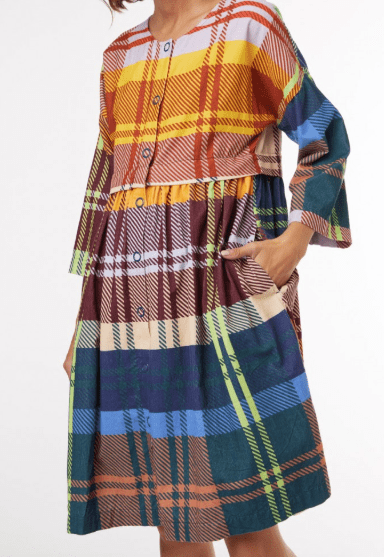For decades sleazy pick up artists have relied on the tried and true method of “peacocking”: dressing in something so outlandish and offensive that women have no choice but to ask them about it. Though perhaps the trick has gone out of vogue as the pick up industry moves on to darker strategies, it remains at the heart of one fashion brand’s business model: Gorman.
The model is simple. First, take a woman devoid of taste and dress her in something so garish, so deeply offensive, that other women are forced to comment on it. Second, (because women’s social interactions are reliant on small compliments and confrontation is rare) another woman will feel obliged to compliment her hideous outfit. Third, the wearer, incapable of creating her own sense of style, mistakes these prompted comments for affirmation she’s dressing well. Fourth, the misguided, and now validated designers create even more horrifying prints for the woman to consume in a depressing race to the bottom.
What is so horrifying about Gorman? Most obviously, the prints. A purple snake print, technicolour plaid and mismatched stripes and spots (featuring on an incredibly unattractive piece titled the ‘Hotpotch Jacket’) are particularly offensive additions this season. The staples of Gorman’s prints are illustrated patterns and cartoons, often created in collaboration with emerging Australian artists. On their own, many are quite pretty. You could imagine them being sold as mass-produced IKEA prints that end up tastefully decorating Annandale rentals. But many are psychotic – collaged stripes, cartoon animals and flowers are mixed together in a bewildering mess. More importantly, neither type has any place on clothing. An inoffensive purple floral print is ruined by being blown up and forced to cover a two-piece suit.
The cuts though, are not much better. One is given the impression that the designers have, at most, only a loose approximation of what a human body looks like. Gorman sells tapered cropped, tapered, pleated jeans: for the woman who wants to look shorter, bow-legged and accentuate her cankles. The paradigmatic printed Gorman sack dress bears special mention. Market research must have indicated to the brand that women object to highlighting their waist or curves. Coupled with the brand’s prints, it gives the effect of an Amish acid trip.

Clothes tell a story. This dress says “I’m fucking unhinged, cunt.” 
A technicolour sack that’ll leave him thinking, “is there a human body under there?”. 
If women are paying $600 to look like this, feminism has a long way to go.
But of course, one cannot go past the raincoats. Despite the fact that the raincoats are ugly, unflattering, not long enough to keep one dry in a downpour, not insulated enough to keep one warm in lieu of an ordinary jacket and made of a sweat-inducing plastic, they are somehow now acceptable as “stylish and practical” outerwear.
The sack dresses, infantile prints and (fucking) raincoats create the overall aesthetic of an overdressed toddler. In fact, in a savvy business move, Gorman recently expanded to include a child’s line. If you didn’t know this, you’d assume it had expanded from a child’s line to include an adult’s line.
Gorman carries an oversized presence in the fashion of young professionals. Frumpy enough to fit into an office setting but garish enough to appear “quirky” and therefore substitute as a personality, Gorman dominates the wardrobes of young media professionals. In a disturbing anecdote, a friend tells me that she’d been encouraged by a MeCo professor to invest in Gorman. “It’s what everyone’s wearing!”
This highlights the central contradiction of Gorman. Though its aesthetic is centred on prints that appear hand drawn and one-off, this is a mirage. Meander down King Street during the Sunday brunch rush and you will realise it’s a strict uniform. There is about as much original thought that goes into wearing head-to-toe Gorman as there is for tweens in General Pants uniforms. There is a small army of women throughout the Inner West ruthlessly committed to looking terrible, and looking the same.





